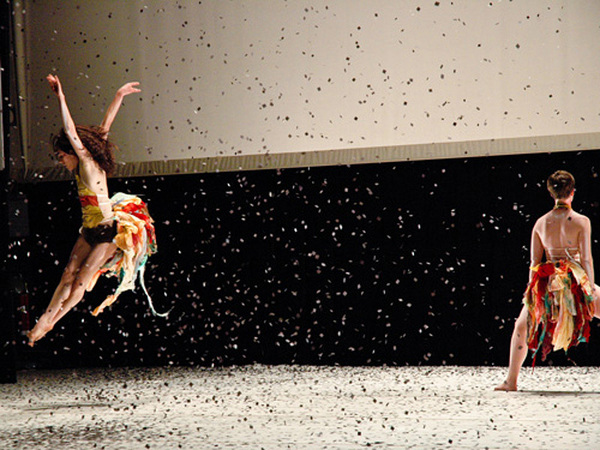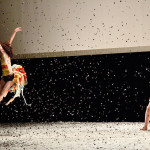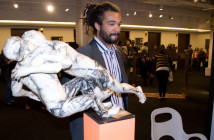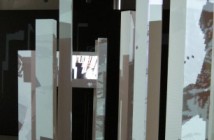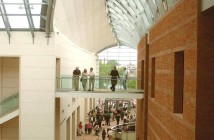ZOE | JUNIPER @ THE ICA
There’s a chance you’ve already seen the collaborative work of performance artist Juniper Shuey and choreographer Zoe Scofield, in a music video for Dave Matthews’ 2007 song Eh Hee. Matthews, seated in a barber’s chair, grimaces and mugs while demonic figures dress him in Mozart’s wig and Chaplin’s hat, cover his face in all kinds of muck, clean him off, and dress him up again. At his side is a coven of dancers, Scofield among them. In quasi-Butoh regalia, they creep through drifts of white powder, posing and writhing to the song’s itchy rhythm. The song isn’t one of Matthews’ best, but Scofield and Shuey’s manic routine comprise four and a half of his most fascinating minutes.
In their group’s Boston debut, zoe | juniper performed the devil you know is better than the devil you don’t on February 20 and 21 at the ICA, presented by World Music/CRASHarts. Zoe Scofield is a 1997 graduate of the dance program at Walnut Hill, the prestigious arts high school in Natick. Juniper Shuey, whose background is in theater, studied set design at Emerson College before moving to the Pacific Northwest, where his career has blossomed. Since 2004, the two have been making dances in Seattle (home also to Dave Matthews).
At an hour long, the devil can’t help but remind you of its creators’ time in music video-land, not only because it looks like the Matthews piece. This dance’s weak spot is the very strength of so many music videos, where over-production is nearly an end goal: the attractiveness of the aesthetic trumps whatever sense the work, specifically its choreography, makes.
But what an attractive aesthetic. From the start, I wanted to find myself transported by this work, and for a time, I was. There’s a rich moment just after the beginning, when a scrim with a projection of falling, staticky snow suddenly drops to reveal—with bracing clarity—a grid of once-fuzzy dancers behind, doing rigid steps in unison. When the choreography after that moment held no similar brilliance, things fell a little slack, recovering only in fits. The work wants to be a grand and insensible dream, from which its dancers slowly awake. But dreams and dances follow different standards. With incisive images and opaque, aimless messaging, dance and dream feel frustratingly conflated.
Overall, the production feels impeccable. Morgan Henderson’s score blends delicacy and propulsion—think of Tortoise’s early work, with grand lo-fi washes. Shuey’s design is spot-on in color and execution—so much that Scofield’s choreography grows washed out by comparison. Scofield herself dances like she’s bewitched, a fascinating mix of Parker Posey and some carnivorous bird. Christiana Axelsen, blond and tall, is also a bold presence, muttering to herself while dancing; Scofield gives a little sneer when she’s tearing through one of many tricky bits.
Chrissy Wai Ching’s costumes carried the night. As the devil progress, and its dancers’ characterizations shift from uniform and pure to frantic and personal, the costumes grow more colorful and ratty. By the end, each dancer resembles a distinct species of prehistoric parrot, their preening accentuated by florid bustles. (And panties made of thick brown fur. Believe it.)
Shuey’s design for the conclusion has stage-snow—confetti—pouring down, first of a clear material, then in black. It was a photo of this gorgeous, vibrant moment that sold me on seeing the show. (I suppose that’s like buying a CD after watching the video.) For those snowy moments, Scofield’s movement is cathartic and primitive, and the live-action snow is a clear, if facile, response to the opening’s digitized version. But catharsis soon turned into dancers just ravishing themselves nonstop. Maybe four times, they halted to do a slow, evil peer from one side of the audience to the other. But once was really enough, especially when you’re never clued in on the peer’s point.
To Scofield’s credit, she has a great sense for how classical line can carve out the body’s appeal, and the choreography is kin with the rest of a visually fruitful collaboration. But Scofield uses ballet’s fashionably floppy version to an extent that risks numbing the eye, draping about fifteen minutes of ideas over an hour’s worth of ambition. When Henderson’s score turned percussive, the steps seemed to find a vitality beyond the trace of their creator, but briefly. These steps—drawing from standard contemporary ballet early on, and turning to primitive flailing near the end—are doomed to underwhelm when surrounded by so much exoticism.
Ultimately, the work’s message seemed delivered by the costumes’ gradual changes, from the opening’s blank uniformity to the closing’s colorful birds, and by those dual versions of snow. Could they be hinting at how we find individuality in a regimented society, by disregarding external concerns? If so, that’s no groundbreaking thesis. What’s more disappointing isn’t that the choreography wasn’t the work’s prime messenger—there’s nothing wrong with tipping the balance of a production—but that the choreography didn’t help deliver the message. Movement shouldn’t need scenery or costumes to clarify, only to deepen. And though the elements of a successful collaboration may well be inextricable, no element should fail to make sense without its mates.
Contemporary dances, of late, seem to set, and fall into, such a trap: long on visual imagination, short on physical messaging, dissatisfying by the end. Blame Sesame Street, or music videos, or the Internet. Or blame how decreased attention for concert dance finds choreographers needing to “sell” their work through just a picture or blurb. More directly though, the teaching of contemporary dance composition seems to have stagnated in America, restricted to universities and well-off schools. So when young and ambitious American choreographers want a revolutionary production, visuals flow freely—we’re the birthplace of MTV, after all—while ideas go neglected. But the meat of any choreography, abstract or not, is not its generated image but its generating idea; failing ideas rich in associations, you’ve got revolutionary-lite. These lopsided dances draw handsomely from contemporary art for a saleable, if trendy, aesthetic. Who though can really say what they’re about? (Last year in a church in New York, I saw a dance with plaster greyhounds, bared breasts and neon lights; it could have been a parody of a Joseph Beuys-Dan Flavin collaboration, except that it conveyed nothing so rich, and wasn’t a parody.) Is it too much to ask for some image-idea parity?
I’m heartened by our piss-poor economy though. In the arts, desperation has a way of breeding invention and distilling voices. So I hope to hear more from Scofield soon. Maybe she’d break through by occasionally making dances on her own.
"the devil you know is better than the devil you don’t" was performed on February 21, 2009 at the Institute of Contemporary Art, in South Boston, MA
Image is courtesy of the Google Image Search

